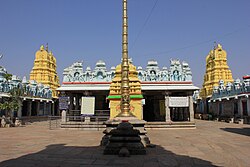Kanakgiri Suvarnagiri | |
|---|---|
town/taluk | |
 Kanakachalapathi temple | |
| Coordinates: 15°33′N76°24′E / 15.550°N 76.400°E | |
| Country | |
| State | Karnataka |
| District | Koppal |
| Population | |
• Total | 22,098 |
| Languages | |
| • Official | Kannada |
| Time zone | UTC+5:30 (IST) |
| PIN | 583283 |
| ISO 3166 code | IN-KA |
| Vehicle registration | KA 37 |
| Nearest city | Gangavathi |
| Lok Sabha constituency | Koppal |
| Vidhan Sabha constituency | Kanakagiri |
| Website | www |
Kanakagiri (also known as Suvarnagiri) is a town in Karnataka state of India. It was a provincial capital of the Mauryan Empire and later became the capital of the Nayaka dynasty who were the Palegars (feudatory) of the Vijayanagara Empire. [1] [2] It is also the site of the historical site Kanakachalapathi Temple (Kanakachalapathi Mandir) which was built by the Nayakas. [1]




